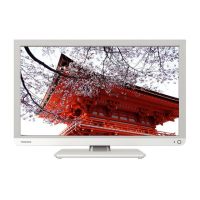
Do you have a question about the Toshiba 32W1333DG and is the answer not in the manual?
| Screen Size | 32 inches |
|---|---|
| Resolution | 1366 x 768 pixels |
| Display Type | LCD |
| HDMI Ports | 2 |
| USB Ports | 1 |
| Backlight | LED |
| Aspect Ratio | 16:9 |
| Refresh Rate | 50 Hz |
| Weight | 6.0 kg |
| Built-in Tuner | Yes |
| Sound Output | 12W (6W x 2) |
Learn how to download and install the latest TV firmware for optimal performance.
Essential advice on TV placement, ventilation, electrical connections, and general usage.
Specific warnings about mains plug, wiring, and excessive sound pressure.
Guidance on selecting a suitable location, ensuring ventilation, and stability.
Information on display characteristics, image retention, and Toshiba's exclusion clause.
Details on DVB-T/C compatibility, regional availability, and encrypted channels.
Precautions for wall mounting, handling power cords, and protecting against storms.
Instructions for safely attaching the TV to a wall mount.
Step-by-step guide to detach the TV's base stand.
A visual guide to all buttons on the remote control and their functions.
How to insert batteries and information on the remote's effective operating distance.
Explains how to connect devices using SCART, HDMI, YPbPr, and aerial cables.
Specifics on digital audio output and HDMI/YPbPr input signal types.
Guide to connecting HDMI sources and using the HDMI input for video and audio.
Instructions for connecting DVI sources, including audio cable requirements.
How to connect a computer via RGB/PC or HDMI for display on the TV.
Connecting DVD players via YPbPr and using USB memory drives for media playback.
Details on energy-saving features, Eco mode, and reducing consumption.
Guidance on contacting qualified personnel for TV repairs.
How to switch the TV on/off and use the remote or TV buttons.
Recommendations for reducing energy use, like dimming screen or unplugging.
Step-by-step guide for initial TV setup, including language and channel scan.
Instructions for performing an automatic scan to find available TV channels.
Explains the different scan types (Digital, Analogue, Full) for channel tuning.
Procedures for manual tuning of digital and cable channels.
Steps for manually searching and fine-tuning analogue channels.
Features related to stereo/bilingual audio and displaying subtitles.
How to access the main menu, adjust volume, and select programmes.
Explains on-screen messages related to standby mode and auto power off.
Managing the channel list, including moving, deleting, and renaming channels.
Instructions on how to lock specific channels using a PIN.
Displays current channel and programme information on screen.
Accessing and navigating the TV schedule for broadcast programmes.
Setting preferred languages for menus, audio, subtitles, and teletext.
Accessing and configuring parental controls for age-restricted content.
Options for locking menus and changing the TV's PIN for security.
Customizing picture settings like mode, contrast, brightness, sharpness, and colour.
Using power save, backlight, and noise reduction features for picture quality.
Adjusting dynamic contrast, colour temperature, and picture zoom for optimal viewing.
Applying film mode, skin tone adjustments, colour shift, and reset options.
Adjusting the screen aspect ratio (16:9, 4:3, etc.) for different content.
Fine-tuning PC image position, dot clock, and phase for clarity.
Automatically adjusts the PC picture position for optimal display.
Controlling volume, equalizer, balance, and headphone output settings.
Selecting sound modes, AVL, dynamic bass, and surround sound options.
Accesses menus for language, parental, timers, sources for personalized settings.
Covers general configurations, conditional access module installation, and usage.
Setting sleep timers and programme timers for automatic TV operation.
Setting the TV's internal clock, including date, time, and time zone.
Enabling or disabling various input sources for quick switching.
Adjusting menu timeouts, scan settings, and operation preferences.
Settings for screen display during signal loss and TV software updates.
Accessibility features and automatic power-off settings for energy saving.
Features related to standby channel scanning and in-store demonstration mode.
How to start and navigate the USB Media Browser interface.
Playing music, viewing photos, and watching videos stored on USB devices.
Instructions for playing MP3 audio files from a USB drive.
Viewing JPEG images and using the slideshow feature with USB photos.
How to play video files, control playback, and use navigation buttons.
Managing subtitle display and audio tracks for video content.
Customizing view styles, slideshow intervals, and subtitle settings within the browser.
Simple instructions on how to exit the Media Player application.
How to access and navigate analogue text services using the TXT button.
Utilizing features like revealing concealed text, holding pages, and accessing initial pages.
A table detailing compatible signal types for AV and HDMI inputs.
Technical pinout details for the PC input connector.
A comprehensive list of supported video, audio, and photo file formats for USB playback.
Key technical details including screen size, resolution, power, and weight.
A list of all items included in the TV package.
Legal information regarding trademarks, licenses, and compliance standards.
Guidelines for environmentally responsible disposal of the TV and batteries.
Solutions for common problems related to sound and picture quality.
Troubleshooting tips for remote control, media browser, and digital channel reception.